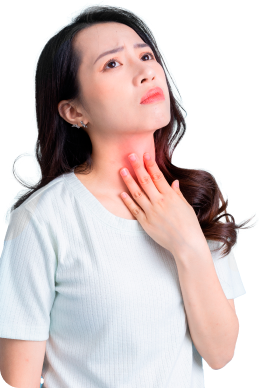Symptom questionnaire quiz
Hereditary angioedema
Наследственный ангионевротический отек (НАО) — это редкое заболевание, характеризующееся повторяющимися эпизодами сильного отека в различных местах по всему телу, включая лицо, конечности, желудочно-кишечный тракт и дыхательные пути1.

Симптомы часто начинаются в детстве, ухудшаются в период полового созревания и сохраняются на протяжении всей жизни с непредсказуемой тяжестью2.

Приступы НАО могут постепенно усиливаться в течение первых 12–36 часов, а затем стихать в течение 2–5 дней3.

Хотя большинство атак НАО происходят спонтанно, важно выявлять возможные провоцирующие факторы. Среди триггеров НАО могут быть: физическая травма, психологический стресс, применение ингибиторов ангиотензинпревращающего фермента, использование эстроген-содержащих препаратов и инфекционные заболевания3.
HAE affects 1/50,000 people worldwide1
НАО поражает 1/50 000 человек во всем мире1

При НАО 93%
пациентов переживают абдоминальные атаки, которые проявляются болью в животе3
Последствия атак НАО при отсутствии лечения4

- Ненужные оперативные
вмешательства4

При НАО более 50%
пациентов испытают более одного приступа отека гортани в течение жизни3
Последствия атак НАО при отсутствии лечения4

- Асфиксия4
- Летальный отек гортани4
Улучшение понимания патофизиологии НАО способствовало разработке новых целевых методов терапии. Препараты для купирования приступов постепенно повысили безопасность и качество жизни пациентов. Эффективные и безопасные профилактические методы лечения теперь открывают для пациентов с НАО путь к нормальной жизни4.
Resourses
- Lopez M A. Hereditary Angioedema Epidemiology. Rare Disease Advisor. (2022)[online]. Link: https://www.rarediseaseadvisor.com/disease‑info‑pages/hereditary-angioedema-
epidemiology/. - Chong-Neto HJ. A narrative review of recent literature of the quality of life in hereditary angioedema patients. World Allergy Organ J. 2023 Mar 20;16(3):100758. doi: 10.1016/
j.waojou.2023.100758. PMID: 36994443; PMCID: PMC10040818. Link: https://pmc.ncbi.nlm.nih.gov/articles/PMC10040818/. - Bork K, Anderson JT, Caballero T, Craig T, Johnston DT, Li HH, Longhurst HJ, Radojicic C, Riedl MA. Assessment and management of disease burden and quality of life in patients with hereditary angioedema: a consensus report. Allergy Asthma Clin Immunol. 2021 Apr 19;17(1):40. doi: 10.1186/s13223-021-00537-2. PMID: 33875020; PMCID: PMC8056543. Link: https://pmc.ncbi.nlm.nih.gov/articles/PMC8056543/.
- Busse PJ, Christiansen SC. Hereditary Angioedema. N Engl J Med. 2020 Mar 19;382(12):1136-1148. doi: 10.1056/NEJMra1808012. PMID: 32187470. Link: https://
pubmed.ncbi.nlm.nih.gov/32187470/. - Doctor discussion guide. (2022). Available at: https://th.knowhae.com/sites/default/files/2022-03/discussion-guide.pdf [Accessed 12 Nov. 2024].
- Henao, M. P., Craig, T., Kraschnewski, J., & Kelbel, T. (2016). Diagnosis and screening of patients with hereditary angioedema in primary care. Therapeutics and Clinical Risk Management, 12, 701. https://doi.org/10.2147/TCRM.S86293.
- Shams, M., Laney, D. A., Jacob, D. A., Yang, J., Dronen, J., Logue, A., Rosen, A., & Riedl, M. (2022). Validation of a suspicion index to identify patients at risk for hereditary
angioedema. Journal of Allergy and Clinical Immunology Global, 2(1), 76–78. https://doi.org/10.1016/j.jacig.2022.08.009. - Stuart, A. (2023). Hereditary Angioedema: Causes, Symptoms, and Treatment. WebMD. Available at: https://www.webmd.com/skin-problems-and-treatments/hereditary-
angioedema. - Maurer, M., Magerl, M., Betschel, S., Aberer, W., Ansotegui, I. J., Aygören‐Pürsün, E., Banerji, A., Bara, N., Boccon‐Gibod, I., Bork, K., Bouillet, L., Boysen, H. B., Brodszki, N., Busse, P. J., Bygum, A., Caballero, T., Cancian, M., Castaldo, A., Cohn, D. M., & Csuka, D. (2022). The international WAO/EAACI guideline for the management of hereditary angioedema—The 2021 revision and update. Allergy, 77(7), 1947-1980. https://doi.org/10.1111/all.15214.
VV-MEDMAT-114905
